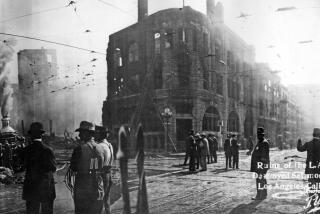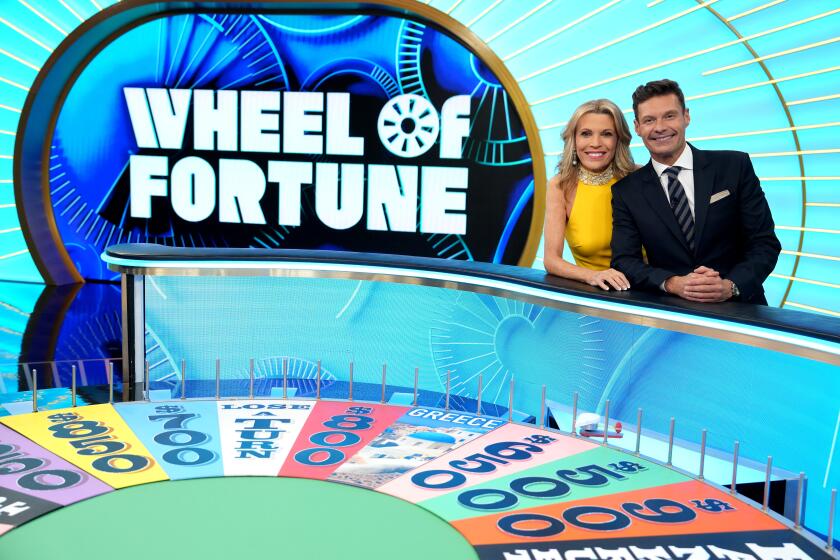Where does the Times go?
OCCASIONALLY, during the year and change that I ran the opinion pages of this newspaper (ending a little over a year ago), I would pick a freeway and drive until I saw a Target or a Wal-Mart. Then I would stop, buy a T-shirt or something and head home. Having foolishly chosen to live downtown before Eli Broad was quite ready for me, this was as good a way as any to learn the lay of the land.
One time, I chose the 101, but quickly got tired and discouraged. So I checked into a motel in what turned out to be Thousand Oaks. (Yes, there is a Target on the 101 just past Thousand Oaks. I know that now.) In the morning, I sought out a Starbucks for coffee and the newspaper. It had the New York Times, like every Starbucks, and it had the Ventura Who-Cares-What-It’s-Called. But no Los Angeles Times. Thousand Oaks is right across the border in Ventura County, yet apparently the L.A. Times couldn’t even manage to get its paper into the local Starbucks.
The Los Angeles Times is a collection of mostly superb journalists who on many days put out the best newspaper in America. But what is the point of publishing a national-quality newspaper if it can’t be obtained in Thousand Oaks, let alone Washington or New York? Tribune Co. is right that you don’t need 1,200 journalists, or even 900, to put out a paper for Los Angeles County. Nor do you need a good website. (And the Times’ -- through no fault of the people currently running it, who do their talented best with little encouragement from management -- is the worst of any major paper.) But why did Tribune pay $8 billion for the Times-Mirror papers in 2000 if its ambitions were so modest?
This won’t be a problem for long. National-quality journalists who work for the L.A. Times, attracted by good salaries and great editors (first, John Carroll and now Dean Baquet), endure the frustration of not being read by the people they write about. If money keeps getting tighter and the paper’s ambitions keep getting narrower, they will leave if they can, or won’t come to work in L.A. in the first place. Then The Times will be an adequate provincial paper like the Chicago Tribune, and the tension of being prettier than the boss’ daughter will be resolved.
My own departure from the L.A. Times does not in any way illustrate this dilemma. An apparatchik anointed by Chicago to be publisher, named Jeffrey Johnson, accepted my invitation to have a discussion about my role and then discussed his view that my services were no longer desired. Why? I still don’t know, exactly. But there are plausible theories, none having to do with money. Jeff let me go so artfully that I was back in my own office before I realized that I’d been canned. Later, he banned my column from the paper too. But since then, Jeff apparently went native (to use the phrase from Friday’s Page 1 story), sided with the editor in opposing the latest round of cuts, and now he’s been fired too. It’s like the French Revolution: You guillotine me, then someone else guillotines you. Sorry, Jeff.
L.A. Times journalists are not entirely blameless for the chaos and carnage. Journalists know how to stage a great hissy fit. And I’m not sure a fit was really called for in the initial staff reductions. On the editorial page (I can reveal, from the safety of hindsight) we initially had 15 people producing 21 editorials a week! So now cries that Tribune Co. has moved from cutting fat to cutting bone ring a bit hollow.
The other issue that ignited flames of self-righteousness in my colleagues was any attempt to integrate The Times into the Tribune chain, or to achieve economies of scale by sharing costs. This sensitivity seems especially shortsighted -- first, because logic was completely on Tribune’s side. (Why should one company be paying four or five reporters to cover the same one-person beat?) And second, because in any merger or pseudo-merger of Tribune papers, the Los Angeles Times would clearly come out on top.
In fact, there may be no better way to preserve The Times’ role as a major newspaper (if that is of any interest to its owners). These days, on the one hand, thanks to the Internet, any newspaper can be a national newspaper. On the other hand, near universal availability of the New York Times print edition makes the traditional role of a regional paper like the Los Angeles Times superfluous.
But now imagine the Tribune chain as a single newspaper with separate editions in each of its cities. Call it the National Tribune. Or the papers could keep their separate identities, but carry a “Tribune” insert or wraparound with national and international news. This paper would start out with towering dominance in two of the nation’s top three markets (Los Angeles and Chicago) and a solid position, via Newsday, in the largest (New York). It would even have a toehold in Washington (thanks to the Baltimore Sun). All this, and Orlando too.
Like the British papers, this new national paper could go after a demographic slice of the market instead of a geographical one. It could aim for the currently unoccupied sweet spot between USA Today and the New York Times, or it could take on the New York Times directly.
I assumed that Tribune Co. must have had something like this in mind when it paid a premium for the Times-Mirror papers. But apparently it had something else in mind, or nothing at all.
And then there is the website. Any newspaper that wants to survive needs a good one, but the Los Angeles Times needs a good one more than any paper in the country. Why? Two reasons. First, because it has national aspirations (or used to) with no national distribution. Of the five “national” newspapers -- the New York Times, Wall Street Journal, USA Today, Washington Post and Los Angeles Times -- the L.A. Times is the only one you cannot obtain in the nation’s capital. Being obtainable in some form is obviously essential to any plan for being obtained.
But mere obtainability isn’t enough. People outside of Los Angeles need a reason to read The Times. Sheer excellence (of which there is plenty) is one reason, but probably not enough.
The Washington Post is also adamantly local in its distribution, but it has a huge national readership online because people want to be in on the conversation in the nation’s political capital. People read the New York Times in part because it is published in the financial capital.
Los Angeles is the capital of the increasingly dominant infotainment-media-celebrity complex. Broaden your scope to California generally and you can throw in high technology as well. The L.A. Times should be the diary of this capital. Often it is. But it has to display its savvy as well as rely on it. In 2006, that means having a website second-to-none, technologically and in terms of content. Having a website that is second to almost everybody suggests that you do not have your finger on the pulse.
Many Angelenos yearn for a Graham or Sulzberger family and rue the day that the Chandlers sold out to “Chicago.” And at least three local billionaires -- the ubiquitous Eli, as well as David Geffen and Ron Burkle -- have said they might like to own it. Former editor Carroll, from a perch at Harvard, is pushing this approach to the problems of newspapers generally.
If I were Dennis FitzSimons, chief executive of Tribune Co., and someone said, “Here is a large check. Take it and you will never have to think about the Los Angeles Times ever again,” I would pinch myself, then grab it and scurry back to the Midwest before the buyer changed his mind or I woke up. But a sale to a local or locals is not likely to produce an equally happy ending for the buyer, or for Los Angeles.
Buying a newspaper is different from inheriting one. These men all made their fortunes in businesses in which the notion that owners should keep their hands off the product doesn’t even have the status of an abstract piety. Inevitably a day would come (my prediction: in less than six months) when the new owner would open the paper and read something upsetting. Then he will call John Carroll and ask, “Tell me again why I’m supposed to pay for this crap?” But he won’t hear the answer because he’ll already be firing Dean Baquet on the other line.
I miss the Los Angeles Times. My very first day on the job, I attended the Page 1 meeting in the newsroom. There was a story about a transient who allegedly had broken into the home of a 91-year-old Hollywood screenwriter -- author of “Abbott and Costello Meet Frankenstein” and later a blacklisted victim of the Red Scare -- cut off his head, climbed over the back fence (head in hand), stabbed a neighbor to death, and was ultimately arrested at Paramount Studios, where guards recognized him from police photos shown on a TV they weren’t supposed to be watching on the job.
What a story! But it didn’t make the front page. It ran in the Metro section. I asked Carroll, “Gosh, who do you have to decapitate to make Page 1 around here?” Now we know.
More to Read
Inside the business of entertainment
The Wide Shot brings you news, analysis and insights on everything from streaming wars to production — and what it all means for the future.
You may occasionally receive promotional content from the Los Angeles Times.










